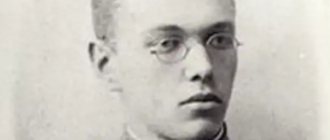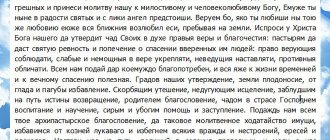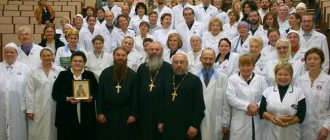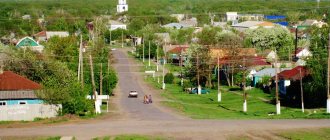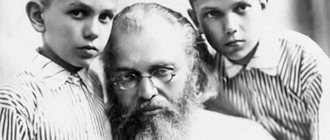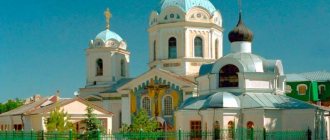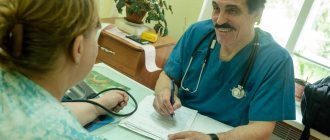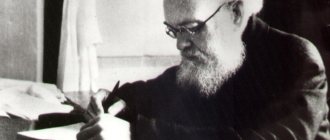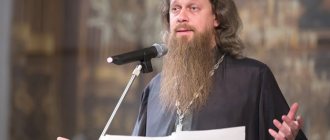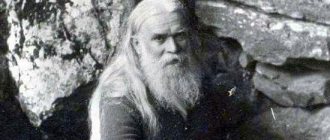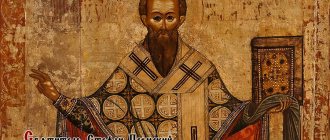Preface
Archbishop Luka (in the world Valentin Feliksovich Voino-Yasenetsky) lived and worked during a difficult period for our country - at the end of the 19th and in the first half of the 20th century, during the years of spiritual crisis, people’s retreat from the faith, wars, revolutions, political repressions, persecution of Church. This is our contemporary - an outstanding doctor and scientist, a brilliant surgeon who saved thousands of lives, a shepherd and preacher, a theologian, an ascetic who restored the churches of God at an unthinkable time, a confessor glorified by the Church, who has shone in the Russian land, performing miracles to this day through the prayers of those who flow with faith. to him. The narrow path of suffering for the truth and serving people, always against the “convenient” current, always faithful to God and love for man - the bright and amazing life of a Christian in times of apostasy, fear and betrayal. Saint Luke lived for eleven years in prisons, camps, and exile. With his spiritual feat and selfless work as a surgeon and “peasant” doctor, he gained nationwide love.
In the 1920s, at the height of the persecution of the Church and its ministers, he became a priest, took monastic vows with the name Luke in honor of the apostle and evangelist, and then was secretly ordained Bishop of Tashkent and Turkestan. Next were the Krasnoyarsk and Tambov departments. In 1946, Archbishop Luka was transferred to Simferopol - his last place of service.
Wherever he was, he served without fear or doubt, preached and treated people, defended the Orthodox faith and the Church in deed, word and writing.
Saint Luke died on June 11, 1961, Sunday, the day of All Saints who shone in the Russian land. Canonized by the Russian Orthodox Church in the host of new martyrs and confessors of Russia for church-wide veneration in 2000.
His Holiness Patriarch Kirill of Moscow and All Rus', making a pastoral visit to the Ukrainian Orthodox Church, venerated the relics of St. Luke resting in the cathedral church of the Holy Trinity Convent in Simferopol. In his word to the flock, His Holiness said:
“...With trepidation I touched the relics of St. Luke, practically our contemporary. I did not have the opportunity to meet him personally, but I had the opportunity to hear a lot about him from those who served with Vladika Luka, who knew him well. He truly was a marvelous archpastor, combining service to the Church and service to science, combining the ability to work in the secular system in the conditions of an atheistic state and at the same time be an archpastor of the Church.
The example of St. Luke teaches us how to find a way out of a seemingly hopeless life situation, how, without compromising with conscience, to be peaceful and calm and to rationally arrange our earthly existence.
Saint Luke was such a person: it would seem that external circumstances suppressed him, but he never broke under this pressure and retained his inner strength, because this strength was in the Orthodox faith. He felt the presence of the Lord in his life and therefore was not afraid of anything, was not afraid of anything, did not shy away from anything, but courageously, with love for people and in peace, he carried out his archpastoral service. Today Saint Luke is a great and bright example for many of us.” [16.]
The Lord Jesus Christ is always the same. We, who are bustling around in a modern “civilized” society, must understand and remember with all our souls and all our hearts that we are all given to each other by the Lord for salvation. It is very important right now, when the boundaries between good and evil, between truth and lies, are being erased, to turn again and again to the life of St. Luke in order to learn from him the courage to stand in the truth, to prayerfully ask for his help in all matters.
Let the life of St. Luke be for us an example of the Christian path in our time, an image of active faith, selflessness and selflessness, labor of love for the Church until the last breath.
This book contains evidence of the feat of Saint Luke, Archbishop of Simferopol and Crimea - a man, a doctor, a shepherd, a saint.
Elena Kruglova
Luka Krymsky (Voino-Yasenetsky),
Archbishop Luka (in the world - Valentin Feliksovich Voino-Yasenetsky) was born in Kerch on April 27, 1877. After graduating from high school, he decided to devote himself to what is useful for suffering people, and chose medicine. After graduating from the university, the future saint was engaged in practice and theoretical research in the field of medicine. In the 20s of the twentieth century, he worked as a surgeon in Tashkent, and actively participated in church life, for example, in meetings of the church brotherhood. The words of Bishop Innocent of Tashkent and Turkestan: “Doctor, you need to be a priest,” he perceived as God’s call. After three years of service as a priest, Father Valentin took monastic vows with the name of the holy apostle, evangelist and physician Luke. On May 31, 1923, Hieromonk Luke, with the blessing of His Holiness Patriarch Tikhon of Moscow and All Rus', was secretly ordained bishop. From that time his confessional journey on the cross began. Numerous arrests, torture and exiles did not weaken the saint’s zeal in fulfilling his archpastoral duty and in his medical service to people.
The “public prosecutor,” security officer Peters, brought the bishop to trial in the so-called doctors’ case (1921). Among the questions was this: “How do you believe in God, priest and professor Yasenetsky-Voino? Have you seen him, your God? “I really haven’t seen God, citizen public prosecutor. But I operated a lot on the brain and, when I opened the skull, I never saw the mind there either. And I didn’t find any conscience there either.”
The “Doctors' Case,” fabricated by Peters, failed miserably, but after some time Vladyka was still subject to repression.
While in his third exile near Krasnoyarsk, already at the beginning of the Great Patriotic War, Bishop Luka offered the authorities his experience and skill to treat wounded Soviet soldiers. Since October 1941, he was appointed consultant to all hospitals in the Krasnoyarsk Territory and chief surgeon of the evacuation hospital. The inspection showed that no other hospital had such excellent results in treating complex infectious joint wounds. Thousands of military personnel were saved from death or lifelong disability.
We had to work in unbearable conditions: the staff was inept and rude, the doctors did not know the basics of surgery. All this had an extremely bad effect on the Vladyka’s health. During operations, he increasingly sat down on a chair: his legs could not support him. It was difficult to climb the hospital stairs: chronic lung disease, emphysema, was making itself felt.
In 1944, Vladyka received a decree of appointment to the Tambov and Michurin Sees, and from 1946 to 1961 he was the ruling bishop of the Simferopol and Crimean diocese.
Vladyka Luke made a number of discoveries. The famous “Essays on Purulent Surgery”, which was published in November 1944, belongs to the famous surgeon. Until now, they are a reference book and textbook for many surgeons.
In December 1945, the saint was awarded the medal “For Valiant Labor in the Great Patriotic War of 1941–1945.” For outstanding achievements in medicine, he received the Stalin Prize of the first degree, which he donated to the needs of orphans. All this meant official recognition of the saint’s selfless work.
In 1958, the Lord sent him a new test - blindness in both eyes. However, the Lord saw with spiritual eyes. Despite his terrible illness, he regularly performed divine services, constantly preached and received the suffering.
His Grace died on June 11, 1961, on the day of All Saints who shone in the Russian land. By the determination of the Synod of the Ukrainian Orthodox Church (Moscow Patriarchate) of November 22, 1995, Archbishop Luke of Simferopol and Crimea was canonized as a locally revered saint. On the night of March 17-18, 1996, the discovery of his incorruptible relics took place, and on May 24-25, 1996, the celebration of the glorification of the saint took place. His multi-healing relics rest in the Holy Trinity Cathedral of Simferopol. In August 2000, the Jubilee Council of Bishops of the Russian Orthodox Church glorified the holy confessor Luke among the host of Russian new martyrs and confessors of the 20th century. His memory is celebrated on June 11 (new art.) / May 29 (old art.) and on the day of remembrance of the Council of Crimean Saints on December 28 (new art.) / December 15 (old art.)
Biography of Saint Luke
Childhood and youth
On April 27, 1877, in the city of Kerch, Felix Stanislavovich Voino-Yasenetsky and his wife Maria Dmitrievna (nee Kudrina) had a third son, Valentin.
The Voino-Yasenetsky family has been known since the 16th century, and its representatives served at the court of the Polish and Lithuanian kings. But gradually the family became poorer, and Valentin Feliksovich’s grandfather already lived in the Mogilev province in a chicken hut, walked in bast shoes, but, however, had a mill.
“The three previous generations of hereditary nobles eked out a rather miserable existence until Felix Stanislavovich broke this centuries-old chain of ever-needy, almost impoverished nobility: he received a provisional education, escaped from the wilderness of the village and settled in the city of Kerch,” writes V. A. Lisichkin , great-nephew of the future Archbishop Luke. [9, p. 21.]
The pharmacy, which Felix Stanislavovich owned for two years, did not bring in much income. He switched to public service and remained an employee of the transport company until his death.
Felix Stanislavovich was a quiet, kind and calm person. He professed the Catholic faith, like his ancestors, but did not impose his views on his children. In his autobiography, Saint Luke remembers him with love: “My father was a Catholic, very devout, he always went to church and prayed for a long time at home. My father was a man of an amazingly pure soul, he saw nothing bad in anyone, he trusted everyone, although in his position he was surrounded by dishonest people. In our Orthodox family, he, as a Catholic, was somewhat alienated.” [1, p. 9.]
The strong-willed Maria Dmitrievna set the tone in family life. She was raised in Orthodox traditions, and her faith was active. “Maria Dmitrievna regularly donated homemade baked goods to those arrested in prison, and arranged opportunities for prisoners to earn money by sending them, for example, mattresses for reupholstery. When the First World War began, milk was constantly boiling in the house, which was sent to wounded soldiers. But Maria Dmitrievna’s living religious feeling was severely traumatized by one unpleasant incident. While celebrating a wake for her deceased daughter, she brought a dish of kutya to the temple and after the funeral service she accidentally witnessed the division of her offering. After that, she never crossed the threshold of the church again.” [10, p. 8.]
In total, the Voino-Yasenetsky family had five children: Pavel, Olga, Valentin, Vladimir and Victoria. Saint Luke recalled his loved ones: “My two brothers – lawyers – showed no signs of religiosity. However, they always went to the removal of the Shroud and kissed it, and they always attended Easter Matins. The older sister, a student, shocked by the horror of the disaster on Khodynskoye Field, became mentally ill and jumped out of a third-floor window, receiving severe fractures of the femur and humerus and ruptured kidneys; this subsequently formed kidney stones, from which she died, having lived only twenty-five years. The younger sister, still alive, is a beautiful and very pious woman.” [1, p. 9, 10.]
The children grew up in an atmosphere of Christian love and obedience. Valentin was an active, very observant and inquisitive child. From the cradle he saw how reverently his father and mother prayed with a large number of bows many times a day; from the age of three, Valentin joined them. As V. A. Lisichkin writes: “Gymnasium student Valentin was under strict control both at home and in the gymnasium. Strict home religious and gymnasium upbringing instilled in Valentin from childhood a deep sense of responsibility before God for all his actions and deeds. From his mother, the boy acquired a strong will and imperious character, and from his father, piety... The family lived very friendly, everyone helped and loved each other.” [9, p. 22.] In his memoirs, Saint Luke also mentions that, having not received a religious upbringing as such, he inherited religiosity “mainly from his very pious father.” [1, p. 10.]
In 1889, the Voino-Yasenetskys moved to Kyiv and settled in the city center, on Khreshchatyk. Valentin entered the Second Kyiv Gymnasium. The rules of behavior here were as strict as in the previous gymnasium. Valentin studied very well, with enthusiasm. I especially loved history and drawing lessons. The parents took the boy's gift seriously. Therefore, when he was 13 years old, he was sent to the Kyiv art school.
Nearby was the Kiev Pechersk Lavra. The church life that was in full swing here, crowds of pilgrims from all over Russia went to worship the Kyiv shrines - all this could not but leave a mark on the life of young Valentin.
“The formation of Valentin’s worldview in the senior classes of the gymnasium was significantly influenced by his older brother Vladimir, a law student. Among the students of those years there was a strong passion for populist ideas. The books of I. S. Turgenev, L. N. Tolstoy and others also contributed to the rise of populist intellectuals among the people. Together with the brothers, Valentin shared a passion for the ethics of Leo Tolstoy” [9, p. 23.], writes V. A. Lisichkin. The passion was strong, Valentin imitated L.N. Tolstoy in everything: “he slept on the floor on a carpet, and in the summer, leaving for the dacha, he mowed grass and rye together with the peasants, keeping up with them.” [1, p. 11.] On October 30, 1897, he wrote a letter to L.N. Tolstoy, in which he asked to influence his stern mother, who did not approve of his plans to become a Tolstoyan. Valentin asked the count for permission to come to Yasnaya Polyana and live under his supervision. The letter remained unanswered. The answer was given by the Lord: L. Tolstoy’s book “What is My Faith?”, published abroad, fell into the hands of the young man, since this work was prohibited in Russia. But this book passed from hand to hand among the students and the older brothers brought it home. After reading the book, Valentin realized that Tolstoyism is nothing more than a mockery of Orthodoxy, and Tolstoy is a heretic, immeasurably far from the truth. Through the labors of his parents and teachers, Valentin’s spiritual world was built, as on a solid stone, on holy Orthodoxy.
So, Valentin successfully graduates from the gymnasium, and when presenting his matriculation certificate, the director gives the graduate a New Testament. Many passages in this holy book made an indelible impression on the young man. In his memoirs, Saint Luke recalls this: “But nothing could compare in the enormous power of impression with that passage in the Gospel in which Jesus, pointing to the disciples’ fields of ripened wheat, said to them: The harvest is plentiful, but the laborers are few. So, pray to the Lord of the harvest to send out laborers into His harvest
(Matthew 9:37). My heart literally trembled, I silently exclaimed: “Oh, Lord! Do You really have few workers?!” Later, many years later, when the Lord called me to be a worker in His field, I was sure that this Gospel text was God’s first call to serve Him.” [1, p. 13.] The family keeps this book with Valentin’s notes, made then in red pencil.
Simultaneously with the gymnasium, he graduated from the Kyiv Art School, “in which he showed considerable artistic abilities, participated in one of the traveling exhibitions with a small picture depicting an old beggar standing with his hand outstretched.” [1, p. 10.]
His passion for painting was very serious, so after graduating from high school, Valentin decided to enter the St. Petersburg Academy of Arts.
A surprising decision was made by a young man pondering his choice of life path:
“Short hesitation ended in the decision that I do not have the right to do what I like, but I am obliged to do what is useful for suffering people. From the Academy I sent a telegram to my mother about my desire to enter the Faculty of Medicine, but all the vacancies were already filled, and I was offered to enter the Faculty of Science in order to then switch to medicine.” [1, p. 10.]
A dislike for the natural sciences changed this plan. Valentin enters the Faculty of Law and for a year enthusiastically studies the history and philosophy of law, political economy and Roman law.
The love for painting did not let go, and a year later he went to Munich to the private art school of Professor Knirr. “However, after three weeks, homesickness uncontrollably drew me home, I left for Kyiv and for another year, with a group of comrades, I intensively studied drawing and painting.” [1, p. eleven.]
Every day, and sometimes twice a day, Valentin went to the Kiev-Pechersk Lavra, often visited Kyiv churches and, returning from there, made sketches of the scenes that he saw in the Lavra and churches. Many talented sketches, sketches and drawings of praying people and Lavra pilgrims were made over almost a year of intense work.
A direction in Valentin’s artistic activity emerged, in which both Vasnetsov and Nesterov worked. “By this time I clearly understood the process of artistic creation. Everywhere: on the streets and on trams, in squares and bazaars - I observed all the pronounced features of faces, figures, movements and upon returning home I sketched it all. At an exhibition at the Kyiv Art School, he received a prize for these sketches of his.” [1, p. 12.]
This daily interaction with pilgrims and praying people during this “rather strange year” was a school of spiritual experience. Valentin inevitably came into contact with the spirit and soul of these people. It was then that the thought occurred to him that this was his flock.
The search for the right path in life, inseparably linked even then with serving the people, continued. Saint Luke recalls: “I could have entered the medical faculty, but again I was overcome by thoughts of a populist nature, and out of youthful ardor I decided that I needed to get down to work that was useful and practical for the common people as soon as possible. Thoughts wandered about becoming a paramedic or a rural teacher, and in this mood I once went to the director of public schools in the Kyiv educational district with a request to place me in one of the schools. The director turned out to be an intelligent and insightful person: he well appreciated my populist aspirations, but very energetically dissuaded me from what I was up to and convinced me to enter the medical faculty.” [1, p. 13.]
This finally decided the question of choosing a life’s work. Having overcome his aversion to natural sciences, Valentin enters the medical faculty of Kyiv University in order to become useful to the peasants, make their lives easier and benefit the people.
University
So, in 1898, Valentin became a student at the Faculty of Medicine of the Kyiv University named after St. Prince Vladimir.
I studied brilliantly. This is how Archbishop Luke recalls these years: “When I studied physics, chemistry, mineralogy, I had an almost physical feeling that I was forcing my brain to work on something that was alien to it. The brain, like a compressed rubber ball, tried to push out content that was alien to it. However, I studied straight A's and suddenly became extremely interested in anatomy. He studied bones, drew and sculpted them from clay at home, and with his dissection of corpses he immediately attracted the attention of all his comrades and the professor of anatomy. Already in my second year, my comrades unanimously decided that I would be a professor of anatomy, and their prophecy came true. Twenty years later I actually became a professor of topographic anatomy and operative surgery.” [1, p. 14.]
What scared many people away from medicine attracted him most of all. In his third year, Valentin became interested in studying operations on corpses. “There was an interesting evolution of my abilities: the ability to draw very finely and my love of form turned into a love of anatomy and fine artistic work in anatomical dissection and during operations on corpses. From a failed artist I became an artist in anatomy and surgery." [1, p. 14.]
Valentin was distinguished by high moral demands on himself and others, sensitivity to other people's suffering and pain, and open protest against injustice and violence. He was soon elected head of the course, which was an expression of respect and trust from his classmates. “In my third year, I was unexpectedly elected headman. It happened like this: before one lecture, I learned that one of my course comrades, a Pole, had hit another comrade, a Jew, on the cheek. At the end of the lecture, I stood up and asked for attention. Everyone fell silent. I made a passionate speech denouncing the ugly act of the Polish student... This speech made such a great impression that I was unanimously elected headman.” [1, p. 15.]
Valentin passed the state exams with straight A's, and the professor of general surgery told him during the exam: “Doctor, you now know much more than I do, because you know all the departments of medicine very well, but I have forgotten a lot that does not directly relate to my specialty.” " [1, p. 15.]
Integrity and truthfulness, aversion to the slightest lie have always distinguished Valentin: “Only in the exam in medicinal chemistry (now called biochemistry) did I get a C grade. I answered excellently on the theory exam, but I still had to do a urine test. As was, unfortunately, customary, the laboratory worker, for the money received from the students, told me what needed to be found in the first flask and test tube, and I knew that there was sugar in the urine that I was offered to examine. However, thanks to a small mistake, the Trommer reaction did not work out for me, and when the professor, without looking at me, asked: “Well, what did you find there?” “I could have said that I found sugar, but I said that Trommer’s reaction did not detect sugar.” [1, p. 15.]
This single C grade did not prevent him from receiving a doctor's diploma with honors.
At the university, he amazed students and professors with his fundamental disregard for career and personal interests. After graduating from the university, this born scientist announced that he would be... a zemstvo doctor - a most unprestigious, difficult and unpromising occupation.
“When we all received our diplomas, my fellow students asked me what I intended to do. When I answered that I intended to be a zemstvo doctor, they said with wide open eyes: “What, you will be a zemstvo doctor?! After all, you are a scientist by vocation!” “I was offended that they did not understand me at all, because I studied medicine with the sole purpose of being a village, peasant doctor all my life, helping poor people.” [1, p. 15, 16.]
